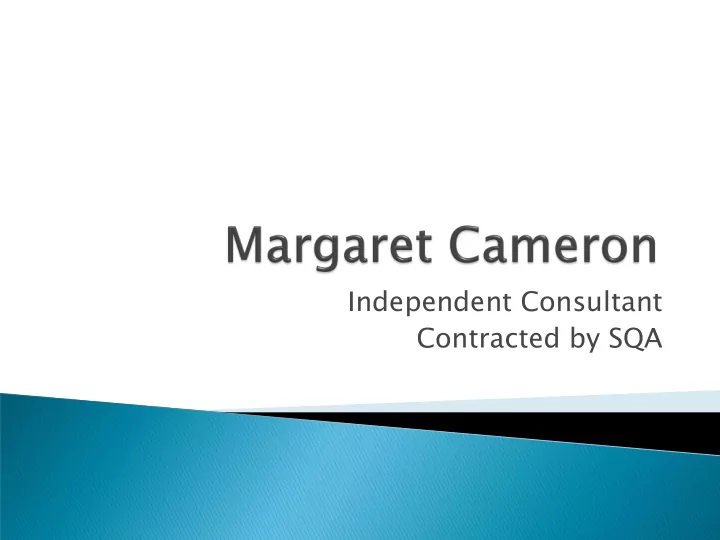

Independent Consultant Contracted by SQA
..an instrument for the development and classification of qualifications according to a set of criteria for levels of learning achieved. OECD Definition ..are broad and abstract descriptive maps of the structure of qualifications within national education systems designed to enable national level comparisons to be made about the equivalence of different qualifications. The Accountability for Quality Agenda in Higher Education
Raffe (2009)identifies 3 approaches 1. Communications Framework: Starting point: existing education and training system. Aims: to improve transparency and understanding, coherence and encourage access and highlight opportunities for transfer and progression. 2. Reforming Framework: Starting point: existing education and training system. Aims: to improve it in specific ways e.g enhancing quality, improving consistency, filling gaps in provision or increasing accountability. 3. Transformational Framework: Starting point: proposed future education and training system Aims: new qualifications, no reference to existing provision.
Teaching and Learning Recognition Qualifications of Prior Design Learning National Levels Qualifications Eg introductory Framework Advanced etc Assessment Quality Assurance Strategies Certification
There are differing views on how the development of frameworks takes place: 3 examples discussed. TUCK OND. VLAANDERAN/HOGERONDERWIJS/ Bologna Expert CEDEFOP
Tuck sets out 3 key requirements: 1. Purpose and Scope What is the NQF trying to achieve and what sectors are to be included? 2. Strategy Will it be a unified framework and to what extent is there central control? Are complimentary policies required to help the NQF achieve what it is setting out to do? What is required to design and implement the framework? 3. Design and Implementation Decisions on level, quality assurance, LOs, assessment, modules/units, credit, institutional requirements. Decisions on Governance arrangements
4 stages: 1. Conceptualisation and design Country analysis, rationale and main policy objectives 2. Consultation and Testing NQF proposal presented, discussion and consultation 3. Official establishment/adoption NQF is adopted and established, normally taking the form of a decree/law or formal agreement between stakeholders 4. Practical implementation Framework moves towards full scale applied practices and requires that institutions comply with the new arrangements and end users informed about the purposes and benefits of the framework
10 stage approach 1. Relevant national body makes decision to start 2. Setting the agenda: clear purpose 3. Organising the process: committee structure, stakeholders/working groups 4. Design profile: level structure, descriptors, credit 5. Consultation: national discussion and acceptance by stakeholders 6. Approval according to national tradition Ministers/Legislation/Government 7. Administrative set up: divisions of tasks of implementation between higher education, quality assurance bodies and other bodies 8. Implementation at institutional level: study programmes amended to learning outcomes based 9. Inclusion of qualifications on the NQF: Accreditation or similar 10. Self certification of compatibility with the EHEA framework
Levels Level descriptors Qualifications Design Criteria ◦ Outcome based ◦ Assessment Quality Assurance Some have Credit, if so may have accumulation and transfer
National Responsibilities Nation identifies reasons for a NQF. Different NQFs for different purposes. Key stakeholders in agreement Identify and agree scope The Builders Research what is already in place within the qualifications system and the legislation Listen, listen more, clarify, propose, consult and listen again!!! Important: Don’t come with fixed ideas
Decisions on: Linked or unified Tight or loose Degree of centralisation Level descriptors ◦ Helps understanding ◦ Provides comparison ◦ Helps progression
Management of the framework, NQF Body - Degree of centralisation / regulation Development and Promotion Qualifications Design: ◦ Learning outcomes, modular/units/courses Quality Assurance Assessment Certification
Consulting with stakeholders Developing NQF Policies Developing guidance documents on how to implement the policies Capacity Building Promoting Advising providers, stakeholders and government Maintaining the Register of Qualifications
The Same Enabling Diversity
Different levels Institutional Teaching and learning, staffing, Programme/qualification Design, Assessment Process Placing qualifications on the framework
Staffing Capacity QA NQF Mapping Resources Body Processes Programme Ensure robust Development QA QA Body Moderation of Assessment Tuck cautions creating a complex and detailed quality assurance system can be a time consuming and controversial process that can delay the building of the framework itself.
TUCK: The task of accrediting all institutions offering qualifications on the NQF is an onerous one. There is a danger of significant delays to NQF implementation if accreditation becomes a pre-requisite. Some countries have adopted the position that all institutions recognised for many years are granted automatic recognition and allowed to offer qualifications on the NQF from the outset. All would be subject to the on-going processes at the audit/review.
Assessments must be: • Valid Planning • Reliable Give Collect • Practical feedback evidence • Quality Assured Make judgement Shift from Norm Referenced and record decision to Criterion Referenced Reference to the NQF on Certification 1 9
Language Trying to do too much too soon Policy borrowing instead of policy `creating’ Qualifications Frameworks have limitations! Beware of unnecessary bureaucracy Complimentary legislation and policies Mutual Trust Question, Read, Feedback, Question Test, refine and consult before implementation
Takes time and work for all involved Institutions need to be `on board`. A successful framework will depend on them to embed the changes and processes Partnerships need to be formed Stakeholders need to be consulted Builders need to listen to what is being said Compromise Legislative change
Recommend
More recommend